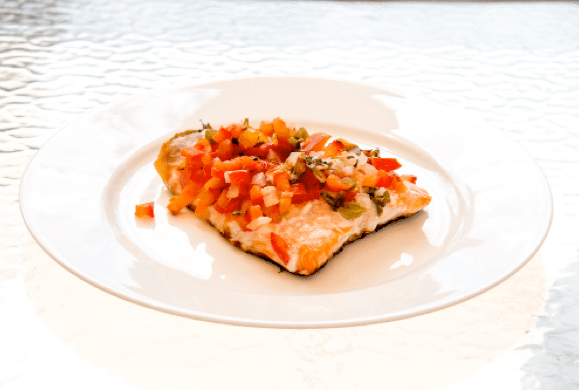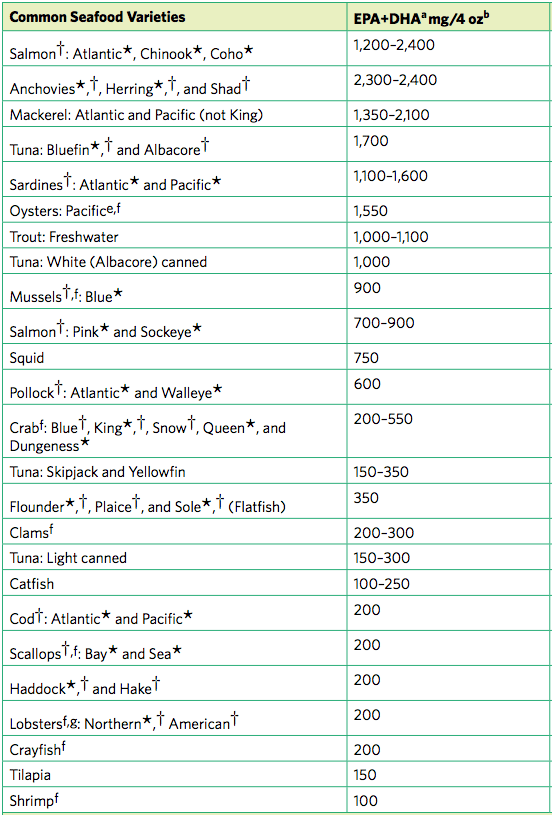Omega-3 Facts for You
 You probably already know that eating seafood high in omega-3 fatty acids is good for your health. It helps to reduce your risk of heart disease by decreasing the risk of abnormal heart beats, decreasing triglyceride levels, slowing down the accumulation of plaque inside blood vessels, and slightly lowering blood pressure (1).Questions about omega-3 fatty acids are among the most commonly asked on the USDA website. There are three main omega-3 fatty acids:
You probably already know that eating seafood high in omega-3 fatty acids is good for your health. It helps to reduce your risk of heart disease by decreasing the risk of abnormal heart beats, decreasing triglyceride levels, slowing down the accumulation of plaque inside blood vessels, and slightly lowering blood pressure (1).Questions about omega-3 fatty acids are among the most commonly asked on the USDA website. There are three main omega-3 fatty acids:
- alpha-linolenic (ALA)
- eicosapentaenoic (EPA)
- docosahexaenoic (DHA)
EPA and DHA are found in fish and seafood. They provide the most health benefits. Some plants like flax, walnuts, and canola oil, contain ALA, which our body partially converts into EPA. DHA is also added to some common foods like milk, juice, and eggs (2). The most common food sources of omega-3 fatty acids are fish and shellfish, flaxseed, walnuts, and canola oil.(3) Want to eat more omega-3s? Use these tips for quick, simple, and delicious meals that are rich in omega-3s! With these strategies, it will be a snap to meet the American Heart Association's recommendation to consume 3.4 ounces of fish high in omega-3s two times per week (1). Salmon, herring, mackerel, bluefin tuna, trout and sardines are the best choices because they all contain 1000-2000 mg or more of omega 3s per 3 ounce serving. DHA eggs contain about 85 mg of DHA. And DHA fortified soy milk contains about 32 mg of omega-3 fatty acids per cup. Fish and seafood are definitely the best sources per serving.Here are ways to enjoy more seafood:Keep it simple. Squeeze fresh lemon juice on a fish fillet and sprinkle with a dash of salt and pepper and your fish is ready for the grill, oven, or a quick sauté on top of the stove.
Want to eat more omega-3s? Use these tips for quick, simple, and delicious meals that are rich in omega-3s! With these strategies, it will be a snap to meet the American Heart Association's recommendation to consume 3.4 ounces of fish high in omega-3s two times per week (1). Salmon, herring, mackerel, bluefin tuna, trout and sardines are the best choices because they all contain 1000-2000 mg or more of omega 3s per 3 ounce serving. DHA eggs contain about 85 mg of DHA. And DHA fortified soy milk contains about 32 mg of omega-3 fatty acids per cup. Fish and seafood are definitely the best sources per serving.Here are ways to enjoy more seafood:Keep it simple. Squeeze fresh lemon juice on a fish fillet and sprinkle with a dash of salt and pepper and your fish is ready for the grill, oven, or a quick sauté on top of the stove.
- On the grill: Wrap seasoned fish in a foil packet, and grill it using indirect heat for about 10 minutes.
- In the oven: Place seasoned fish on a greased baking pan, and bake in a 425 degree oven for about 15 minutes.
- Quick sauté: Heat 1-2 teaspoons of olive or canola oil or butter in a nonstick skillet. Add the seasoned fish and cook for 1-4 minutes per side, until each side is golden and the fish flakes easily.
Spice it up. Use your favorite seasoning mix such as lemon pepper, Cajun, or a seafood seasoning blend to give fish a flavorful kick.The freezer is your friend. Purchase plain frozen fish fillets and stock your freezer with healthful protein that’s ready in minutes. Avoid breaded fish and instead choose a plain fillet that you season yourself. You can find salmon on sale in your grocer's seafood section and stock up when prices are good. Have the seafood clerk cut the fish in 3 ounce servings so you have the proper sized portion. Check out our salmon recipes online.Fish is cooked through and ready to eat when it flakes easily with a fork and the flesh is opaque. The USDA recommends an internal temperature of 145 degrees F for safety and delicious texture.Here is a chart from the Dietary Guidelines: By Lynn Grieger, RDN, CDE, CPT, CWCHere is a free powerpoint file with 5 slides for omega 3 education.Here is a free PDF handout infographic for omega-3.Sources:
By Lynn Grieger, RDN, CDE, CPT, CWCHere is a free powerpoint file with 5 slides for omega 3 education.Here is a free PDF handout infographic for omega-3.Sources:
- Fish and Omega-3 Fatty Acids. American Heart Association. http://www.heart.org/HEARTORG/GettingHealthy/NutritionCenter/HealthyDietGoals/Fish-and-Omega-3-Fatty-Acids_UCM_303248_Article.jsp. Reviewed 8-8-13; accessed 11-4-13.
- 2. Omega-3 Fatty Acids. L. Bellows, M. Bunning and M. MacDonald. Colorado State University Extension. http://www.ext.colostate.edu/pubs/foodnut/09382.html Updated 4-19-13; accessed 11-4-13.
- USDA http://www.ars.usda.gov/Main/docs.htm?docid=6233#omgea
- http://content.onlinejacc.org/article.aspx?articleid=1139945
Ready for more nutritional fun? Check out the resources that are ready for you in the Nutrition Education Store...

